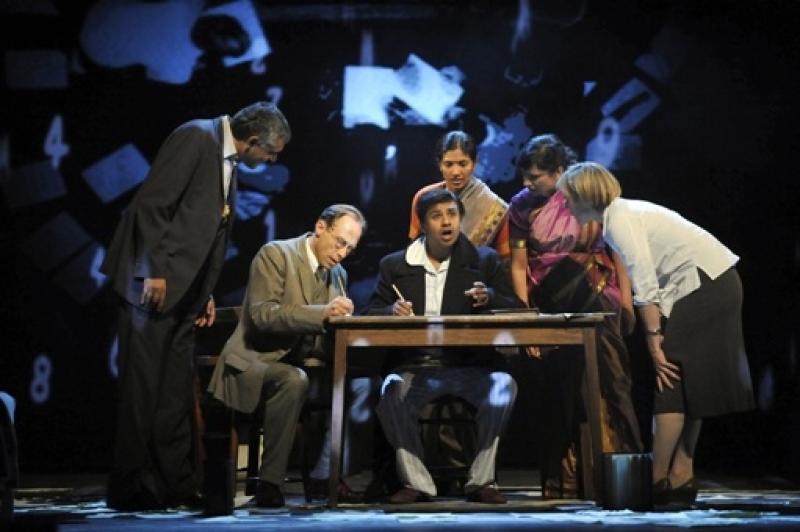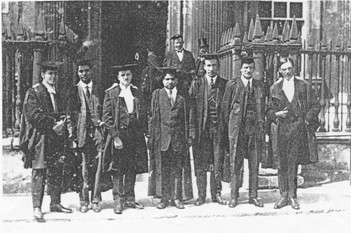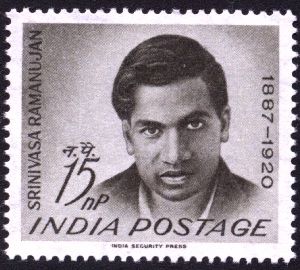Complicite and the Mozart and Salieri of Maths | reviews, news & interviews
Complicite and the Mozart and Salieri of Maths
Complicite and the Mozart and Salieri of Maths
Complicite's A Disappearing Number is not the first time Srinivasa Ramanujan's story has been told

In 1913 a 25-old-year mathematician from Tamil Nadu sailed to England. He journeyed at the behest of a Cambridge professor who had been mesmerised by the display of untutored genius evident in the young Indian’s correspondence. Within four years the visitor had grown so depressed by his isolation that he attempted to throw himself under a train.
Nearly a century on, the story of the collaboration between Srinivasa Ramanujan and G H Hardy began suddenly exciting the interest of storytellers. In 2007 there was a play premiered off Broadway by David Freeman called A First Class Man. Also in America there was The Indian Clerk, a hefty novel by David Leavitt. There are at least rumours of two films in development (although a green light for one may kill off the other). One is based on Robert Kanigel’s 1991 biography, The Man Who Knew Infinity. The second is an Anglo-Indian venture involving our own resident Cambridge-educated genius, Stephen Fry. It wouldn't be his cinematic debut: he is spoken of in awed tones in Good Will Hunting (1997).
Ramanujan's story as told to Robin Williams in Good Will Hunting
Ramanujan’s odyssey also attracted the attention of Complicite, the avant-garde theatre company renowned for sourcing drama in the unlikeliest places. Other recent outings include The Elephant Vanishes, which adapted Haruki Murakami’s surreal tales of urban dislocation, and Mnemonic, suggested by the Alpine disinterment of a Neolithic corpse. Shun-kin, the company's producton based on two stories by Japanese author Jun'ichiro Tanizaki, returns to the Barbican in November. A Disappearing Number, a play inspired by mathematics’s odd couple, made its first appearance in 2007, also at the Barbican, and exhilarated audiences. This year it has been to New York, Mumbai and Hyderabad, where it was performed as part of the International Congress of Mathematicians. It is now taking up temporary residence in the West End before being broadcast from the Theatre Royal Plymouth to cinemas around the world by National Theatre Live.
It’s not difficult to see what attracts more conventionally minded storytellers to Ramanujan. His name joins a tiny pantheon of enigmatic figures from 20th-century history who puzzle the modern imagination. Several years ago, for example, there was a little spate of plays about Albert Speer, most opaque of the Nazis, each of them worrying away at the great imponderable of just how much Hitler’s architect knew. Around the same time, two novels, an art installation and a multi-media theatre piece similarly tackled the riddle of Donald Crowhurst, the amateur sailor who went mysteriously round the twist during a round-the-world yacht race in 1968.
It is as if both men, grappling in perpetuity with their demons, had melded into the realm of ancient fable. Each of them became a blank canvas on which creative minds felt free to daub. Ramanujan seems to be cut from the same cloth. When East and West are thinking about each other more watchfully than ever, a tale about cross-cultural number-crunching with a hint of a homosexual subtext catches the light in all sorts of intriguing ways. As Hardy put it in a Harvard lecture in 1935, “I suppose it is difficult for an Englishman and an Indian to understand each other.”
 For Simon McBurney, Complicite’s artistic director, this is more than just a tale of two boffins. He came across Ramanujan’s story 14 years ago when Michael Ondaatje recommended Hardy’s memoir, A Mathematician’s Apology. Himself the son of a Cambridge professor, he admits to having struggled as an arty child with mathematics’ authoritarian creed of right and wrong. “I read it and became very excited because it wasn’t just about mathematics but about the nature of the imagination,” he says. “As I began to read more, I discovered that great mathematicians worked through an extraordinary sense of instinct and intuition and above all imagination, and that mathematics was created throughout history by leaps of the imagination.” This was the lure. Marooned in Cambridge, Ramanujan was a Brahmin among Christians, a vegetarian among carnivores, but above all a mathematical fantasist among empiricists. (Pictured above right: Ramanujan at Trinity College Cambrdige; Hardy is on the right.)
For Simon McBurney, Complicite’s artistic director, this is more than just a tale of two boffins. He came across Ramanujan’s story 14 years ago when Michael Ondaatje recommended Hardy’s memoir, A Mathematician’s Apology. Himself the son of a Cambridge professor, he admits to having struggled as an arty child with mathematics’ authoritarian creed of right and wrong. “I read it and became very excited because it wasn’t just about mathematics but about the nature of the imagination,” he says. “As I began to read more, I discovered that great mathematicians worked through an extraordinary sense of instinct and intuition and above all imagination, and that mathematics was created throughout history by leaps of the imagination.” This was the lure. Marooned in Cambridge, Ramanujan was a Brahmin among Christians, a vegetarian among carnivores, but above all a mathematical fantasist among empiricists. (Pictured above right: Ramanujan at Trinity College Cambrdige; Hardy is on the right.)
Ramanujan’s all-consuming interest in numbers – and indifference to other subjects - ensured that he left university in Madras without a degree. In the ensuing years he was married off to a nine-year-old bride, endured ill health and poverty before he found work at the Madras Port Trust Office. His notebooks did eventually come to the attention of the Indian Mathematical Society, and once it became clear that they had nothing to teach him, Ramanujan was encouraged to write to professors in England. Two Cambridge mathematicians returned his papers without comment. He had better luck with G H Hardy, whose Orders of Infinity he had devoured.
“In hall I found Hardy and Littlewood [another professor] in a state of high excitement”, wrote Bertrand Russell after dinner at high table in Trinity, “because they believe they have discovered a second Newton, a Hindu clerk in Madras on £20 a year.” A flurry of letters followed in which the Cambridge professor, though staggered by Ramanujan’s work on prime numbers, expressed frustration at the Indian’s nonchalance with regards to proof.
It is a very interesting number. It is the smallest number expressible as the sum of two cubes in two different ways
“Hardy was brought up on proof,” says Marcus du Sautoy, a professor of mathematics at Oxford whose popular book The Music of the Primes prompted McBurney to invite him aboard as a consultant. “Maths doesn’t exist if you don’t prove it. Ramanujan was much more interested in making discoveries and not giving justifications. He would make these amazing connections between formulas and Hardy could see that they were right but couldn’t understand how Ramanujan had got there.” Ramanujan believed that his proofs were divinely supplied by the family deity, Namagiri. However infuriating this was for Hardy, Namagiri did also intervene in his favour. Ramanujan had been reluctant to sail to England because in the Brahmin belief-system it would make him an outcast, but the goddess appeared in a dream and decreed that he should travel.
Hardy later described Ramanujan’s appearance as “the one romantic incident of my life”. He didn’t necessarily mean that love bloomed in his desert heart. Du Sautoy compares the two of them to “Hillary and Tensing, two explorers striking across this hostile land”. McBurney sees in them something of Salieri and Mozart. Their work on prime numbers was finally unproductive, but in the field of partition numbers they made remarkable breakthroughs. They were pulled along by Ramanujan’s bright-eyed faith. “The partition number of five is the number of different ways I can group five stones,” explains Du Sautoy. “There are seven ways to partition them. Hardy believed you could never get a formula for it. Ramanujan felt there should be. Together they came up with a ridiculously complicated formula which involves every function of the two millennia we’ve been doing maths. They made many discoveries, but that was their most stunning piece of proof.”
 Away from his calculations, Ramanujan suffered. Malnutrition caused by the poor vegetarian fare contributed to his depression, as did his failure to win a fellowship. Trinity had already stripped the anti-war Russell of his, and in 1917 were wary of honouring a pacifist Brahmin. After his suicide attempt, illegal at the time and anyway thwarted because the train braked in time, Hardy saw to it that he didn’t have to face charges and deposited him in a sanatorium in Matlock. Ramanujan shivered and pined until Hardy had him moved to Putney.
Away from his calculations, Ramanujan suffered. Malnutrition caused by the poor vegetarian fare contributed to his depression, as did his failure to win a fellowship. Trinity had already stripped the anti-war Russell of his, and in 1917 were wary of honouring a pacifist Brahmin. After his suicide attempt, illegal at the time and anyway thwarted because the train braked in time, Hardy saw to it that he didn’t have to face charges and deposited him in a sanatorium in Matlock. Ramanujan shivered and pined until Hardy had him moved to Putney.
While visiting, by way of small talk, Hardy volunteered that his taxi had the very dull number of 1,729. “No, Hardy!” responded Ramanujan. “It is a very interesting number. It is the smallest number expressible as the sum of two cubes in two different ways.” That was their lingua franca. Soon after his discharge, Hardy urged Ramanujan to return to India to recuperate. He died of an intestinal infection not long after, at the age of 33. Hardy was also prey to the black dog as his powers waned in old age, but his attempt to take his own life failed when he regurgitated an overdose.
In their usual style of discovery through improvisation, Complicite use the story of their work on partition numbers as a springboard into a wider narrative about emotional, political and cultural partition. “I’m not interested really in this story as one particular specific touching tale”, says McBurney, “but in a rather larger metaphorical application of what it implies, of how creativity consumes you, how it’s at the same time an extraordinarily human activity, this absolute compulsion to understand, but at the same time this compulsion to understand can have tragic consequences.”
Explore topics
Share this article
The future of Arts Journalism
You can stop theartsdesk.com closing!
We urgently need financing to survive. Our fundraising drive has thus far raised £49,000 but we need to reach £100,000 or we will be forced to close. Please contribute here: https://gofund.me/c3f6033d
And if you can forward this information to anyone who might assist, we’d be grateful.

Subscribe to theartsdesk.com
Thank you for continuing to read our work on theartsdesk.com. For unlimited access to every article in its entirety, including our archive of more than 15,000 pieces, we're asking for £5 per month or £40 per year. We feel it's a very good deal, and hope you do too.
To take a subscription now simply click here.
And if you're looking for that extra gift for a friend or family member, why not treat them to a theartsdesk.com gift subscription?
more Theatre
 Ragdoll, Jermyn Street Theatre review - compelling and emotionally truthful
Katherine Moar returns with a Patty Hearst-inspired follow up to her debut hit 'Farm Hall'
Ragdoll, Jermyn Street Theatre review - compelling and emotionally truthful
Katherine Moar returns with a Patty Hearst-inspired follow up to her debut hit 'Farm Hall'
 Troilus and Cressida, Globe Theatre review - a 'problem play' with added problems
Raucous and carnivalesque, but also ugly and incomprehensible
Troilus and Cressida, Globe Theatre review - a 'problem play' with added problems
Raucous and carnivalesque, but also ugly and incomprehensible
 Clarkston, Trafalgar Theatre review - two lads on a road to nowhere
Netflix star, Joe Locke, is the selling point of a production that needs one
Clarkston, Trafalgar Theatre review - two lads on a road to nowhere
Netflix star, Joe Locke, is the selling point of a production that needs one
 Ghost Stories, Peacock Theatre review - spirited staging but short on scares
Impressive spectacle saves an ageing show in an unsuitable venue
Ghost Stories, Peacock Theatre review - spirited staging but short on scares
Impressive spectacle saves an ageing show in an unsuitable venue
 Hamlet, National Theatre review - turning tragedy to comedy is no joke
Hiran Abeyeskera’s childlike prince falls flat in a mixed production
Hamlet, National Theatre review - turning tragedy to comedy is no joke
Hiran Abeyeskera’s childlike prince falls flat in a mixed production
 Rohtko, Barbican review - postmodern meditation on fake and authentic art is less than the sum of its parts
Łukasz Twarkowski's production dazzles without illuminating
Rohtko, Barbican review - postmodern meditation on fake and authentic art is less than the sum of its parts
Łukasz Twarkowski's production dazzles without illuminating
 Lee, Park Theatre review - Lee Krasner looks back on her life as an artist
Informative and interesting, the play's format limits its potential
Lee, Park Theatre review - Lee Krasner looks back on her life as an artist
Informative and interesting, the play's format limits its potential
 Measure for Measure, RSC, Stratford review - 'problem play' has no problem with relevance
Shakespeare, in this adaptation, is at his most perceptive
Measure for Measure, RSC, Stratford review - 'problem play' has no problem with relevance
Shakespeare, in this adaptation, is at his most perceptive
 The Importance of Being Earnest, Noël Coward Theatre review - dazzling and delightful queer fest
West End transfer of National Theatre hit stars Stephen Fry and Olly Alexander
The Importance of Being Earnest, Noël Coward Theatre review - dazzling and delightful queer fest
West End transfer of National Theatre hit stars Stephen Fry and Olly Alexander
 Get Down Tonight, Charing Cross Theatre review - glitz and hits from the 70s
If you love the songs of KC and the Sunshine Band, Please Do Go!
Get Down Tonight, Charing Cross Theatre review - glitz and hits from the 70s
If you love the songs of KC and the Sunshine Band, Please Do Go!
 Punch, Apollo Theatre review - powerful play about the strength of redemption
James Graham's play transfixes the audience at every stage
Punch, Apollo Theatre review - powerful play about the strength of redemption
James Graham's play transfixes the audience at every stage
 The Billionaire Inside Your Head, Hampstead Theatre review - a map of a man with OCD
Will Lord's promising debut burdens a fine cast with too much dialogue
The Billionaire Inside Your Head, Hampstead Theatre review - a map of a man with OCD
Will Lord's promising debut burdens a fine cast with too much dialogue

Add comment